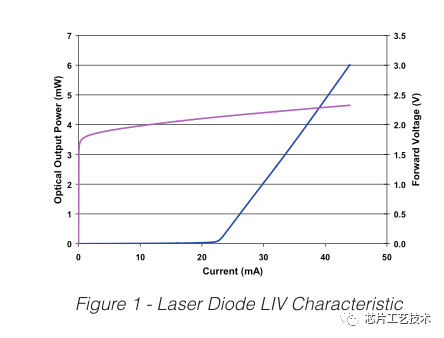The reliability of laser chips is a crucial indicator. Whether it is a low-power laser pen or a laser communication chip with high requirements, chip aging and reliability testing are required.
Compared to traditional electronic chips, laser testing is more complex, involving optical and electrical measurements, and also considering differences in packaging forms. Aging test is a testing method for chips. In the early stages of research and development, it can also obtain a lot of chip quality information through chip aging test, which can search for early process problems, etc.
We know that laser chip measurements are generally based on LIV data, as shown in the following figure:
The photoelectric parameters of the laser are greatly affected by heat.
As shown in the above figure, as the temperature increases, the threshold current of the chip increases.
Usually, after the completion of a wafer, a wafer level inspection is carried out first. At this time, since it is not possible to test the side light emission, no power on inspection is usually conducted. Instead, the appearance and key dimensions of some chips are checked.
After splitting into bar bars in the second step, the light situation can be preliminarily tested, as there is no specific light emitting surface or reflective surface, so it is not a completely correct laser mode. The luminous power can be simply assumed to be the same at both ends.
The third step is to coat the AR surface and HR surface, and then conduct Bar strip testing, which can be divided into separate chip particles after testing.
Aging can only be carried out after the chip packaging is completed, such as To9 packaging.
The lifespan of a chip can be determined using the Arrhenius formula: Arrhenius equation is a chemical term and an empirical formula established by Arrhenius of Sweden for the relationship between the chemical reaction rate constant and temperature.
Appropriating it to a laser chip is:
As shown in the above figure, the laser with Ea=0.7eV has a lifespan of 100000 hours at room temperature of 20 ℃, but only 2300 hours at 70 ℃.
The lifespan test of packaged chips generally requires 1000 hours of aging, or even longer. There is a Telcordia testing standard specifically designed for laser testing in the communication industry.
Accelerated aging is a means of rapid testing, using high temperatures, high injection currents, or higher light output power. High temperature is a commonly used direction.
Three commonly used testing modes for aging:
1) The constant current mode provides an ACC (automatic current control) mode during the aging process, which is also known as the constant current mode.
2) The constant power mode, also known as APC (automatic power control), maintains a constant optical power of the emitted light (by adjusting the current supply). Power mode is commonly used in aging testing because it is closer to the actual application scenario.
3) Regular testing. Place the laser in a 100 ℃ environment and regularly take it out for measurement.
In actual aging engineering, if periodic testing is used for lasers, there will also be many external factors, mainly temperature instability, unstable equipment measurement and control, equipment reliability, and power failure. One reason for the difficulty in temperature control is the self heating of the laser. Even with the To can packaging tightly mixed with exposed aluminum heat sinks, the laser still has a thermal resistance of 5-10C/W. If the laser operates under conditions of 100mA and 1.8V, there may be a temperature difference of 1.5 ℃ between the laser interior and the heat sink.
In addition, the laser is very sensitive to temperature at a given current, even if the heat sink fluctuates only by 0.1 ℃, it will cause noise in the output optical power. Moreover, external photodiodes used for measurement are also affected by temperature, resulting in different optical power data. Therefore, temperature control is also necessary.
Laser life cycle research requires precise measurement of laser operating parameters and even percentage changes over thousands of hours. Therefore, the stability of the testing equipment must reach 0.1% within 1000 hours.
The above figure shows the test results of 16 DFB lasers in APC mode at 75 ℃ for 1000 hours.
Usually, the fastest aging rate occurs a few hundred hours before the start of testing, followed by a stable linear aging characteristic, where the service life of each laser is a straight line in the linear region. So it is possible to infer the service life under predefined currents.
If a current change of 20% is used as the end of its service life. The estimated service life at 75 ℃ ranges from 360 hours to 16450 hours, and based on Weibull probability distribution, the average service life is 2200 hours.
The above figure shows a straight line drop at 930 hours, which is caused by a sudden power outage of the aging system. After subsequent power on, the graph can continue to move, indicating that aging can be interrupted, but try not to plug or unplug it. Laser2 can observe unstable readings at 500-800 hours, which is also a common phenomenon in aging testing. It is related to testing hardware and techniques, and there is no need to pay too much attention. It may jump when there is a vibration nearby.
Aging is an important process in laser product screening, screening out products that may have a shorter lifespan, so that the remaining large number of lasers have satisfactory and acceptable reliability. Due to the impact of aging on production costs and time, the aging time is generally less than 100 hours.
